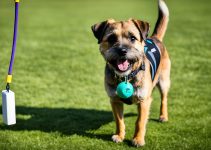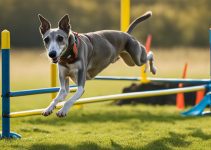Dachshund training can be a rewarding experience, but it may pose challenges for first-time owners. Dachshunds are intelligent and independent dogs, which can make training more difficult. In this article, I will provide you with effective Dachshund training tips to help you train your furry friend in obedience, house etiquette, and playful tricks.
First and foremost, it is crucial to understand the unique characteristics of the Dachshund breed. They are known for their independence, intelligence, and stubbornness, which can impact their training. Additionally, Dachshunds have a strong prey drive and were originally bred for hunting, making them easily distracted and prone to chasing.
When it comes to training goals for Dachshund puppies, starting early is key. Breeders play a crucial role in socializing puppies and exposing them to various experiences, people, and other dogs. Additionally, housetraining and teaching basic behaviors such as sit, down, and come should be initiated early on. Puppy kindergarten classes or programs like AKC S.T.A.R. Puppy can also enhance socialization and basic training.
Housetraining and crate training are important aspects of Dachshund training. Establishing a regular schedule for taking your Dachshund puppy to a designated potty area and using positive reinforcement when they eliminate in the appropriate spot is vital. Crate training can also help with housetraining, as it teaches puppies to hold their bladder and bowels.
Leash training and behavioral training are essential for Dachshunds. Leash training helps address their strong instinct to explore and easily get distracted. Positive reinforcement and consistency are key in leash training. Behavioral training focuses on addressing any behavioral issues, such as excessive barking or digging. Consistency, patience, and positive reinforcement are crucial for successful leash and behavioral training.
Command training and obedience training are fundamental for teaching Dachshunds to respond to specific commands and follow basic commands. Consistency, positive reinforcement, and reward-based training methods are key in these training aspects. Short and enjoyable training sessions help maintain the dog’s focus and motivation.
Once the basic training is established, you can move on to teaching your Dachshund tricks and engaging in agility training. Tricks training provides mental stimulation and strengthens the bond between you and your dog, while agility training keeps them physically active and challenges their intelligence and agility. For more advanced training, Dachshunds excel in activities like obedience competitions and scent work.
Dachshund training requires patience, consistency, and positive reinforcement. Understanding the unique characteristics of the breed and starting training early are key to success. Remember to establish clear training goals, use reward-based techniques, and provide mental and physical stimulation. With the right training approach, you can help your Dachshund become a well-behaved and obedient companion.
Effective Dachshund Training
- Dachshund training can be challenging but rewarding for first-time owners.
- Dachshunds are intelligent, independent, and have a strong prey drive.
- Start training goals early for Dachshund puppies, including socialization and basic behaviors.
- Use crate training and establish a regular schedule for housetraining.
- Leash and behavioral training require consistency, patience, and positive reinforcement.
Understanding the Dachshund Breed
Dachshunds are a unique breed with distinct characteristics that can impact their training. They are known for their independence, intelligence, and stubbornness, which can make training a challenge. Dachshunds have a strong prey drive and were originally bred for hunting, which means they can be easily distracted and may have a strong instinct to chase. It is important for owners to be patient, consistent, and firm when training a Dachshund.
Dachshund training requires understanding their breed-specific traits. Their independent nature makes them less reliant on their owners compared to other breeds. This independence can manifest in stubbornness, which can make training more challenging. However, their intelligence makes them capable of learning and comprehending commands. It is important to approach training sessions with patience and a positive attitude, reinforcing desired behaviors with rewards and motivation.
Dachshunds thrive on mental stimulation, so incorporating interactive toys and puzzle games can help alleviate boredom and keep them engaged. Dachshund training sessions should be kept short and focused to maintain their attention span. Consistency is key in ensuring they understand what is expected of them. By establishing clear boundaries and rewarding good behavior, owners can overcome the challenges and successfully train their Dachshunds.
Starting Early: Training Goals for Dachshund Puppies
When it comes to training Dachshund puppies, starting early is crucial. As a first-time owner, I understood the importance of setting clear training goals from the beginning. To ensure my Dachshund puppy grows up to be a well-behaved and obedient companion, I focused on key areas such as socialization, housetraining, and instilling basic behaviors.
Socialization
From day one, I prioritized socializing my Dachshund puppy. I knew that early positive experiences with various people, other dogs, and environments would help shape their behavior and reduce the likelihood of future aggression or fearfulness. I introduced my puppy to different sounds, sights, and situations, gradually exposing them to new experiences and ensuring they felt comfortable and confident in different social settings.
Housetraining
Housetraining was another essential goal for my Dachshund puppy. I established a routine to teach them where to eliminate and made sure to praise them when they did it in the designated area. By being consistent and patient, I was able to help my puppy develop good bathroom habits and prevent accidents inside the house.
Basic Behaviors
Teaching basic behaviors like sit, down, and come was an important part of my Dachshund puppy’s training. Using positive reinforcement techniques, I rewarded my puppy with treats and praise whenever they successfully performed these commands. By starting early and keeping training sessions short and enjoyable, my puppy quickly learned these basic behaviors and became more responsive to my instructions.
I also enrolled my Dachshund puppy in puppy kindergarten classes, which provided a structured environment for socialization and basic training. Programs like AKC S.T.A.R. Puppy were particularly beneficial as they focused on socialization, training, and responsible ownership.
Starting early, setting training goals, and providing proper socialization and basic training were key factors in helping my Dachshund puppy become a well-rounded and well-behaved companion.
Housetraining and Crate Training
When it comes to Dachshund training, housetraining is an essential skill to teach. Establishing a regular schedule for bathroom breaks and designating a potty area are important steps in the process. By following a consistent routine, you can help your Dachshund understand where it’s appropriate to eliminate.

Crate training is another valuable tool for housetraining. This method teaches puppies to hold their bladder and bowels, as well as providing them with a safe and comfortable space of their own. When introducing crate training, it’s important to make it a positive and stress-free experience for your Dachshund. Use treats, toys, and praise to create a positive association with the crate.
Remember, patience and positive reinforcement are key during the housetraining and crate training process. Celebrate your Dachshund’s successes, and never punish or scold them for accidents. With consistency and gentle guidance, your Dachshund will become a pro at housetraining in no time!
Leash Training and Behavioral Training
Proper leash training is essential for Dachshunds to ensure their safety and prevent them from running off or getting into trouble. These curious little dogs have a strong instinct to explore and can easily get distracted. By leash training your Dachshund, you can have better control and keep them safe during walks.
To effectively leash train your Dachshund, it is important to use positive reinforcement techniques. This means rewarding your dog for good behavior on the leash, such as walking calmly without pulling. Positive reinforcement can be in the form of verbal praise, treats, or a favorite toy. Consistency is key in reinforcing desired behavior and helping your Dachshund understand what is expected of them.
Behavioral training is another crucial aspect of Dachshund training. Dachshunds can sometimes exhibit behavioral issues such as excessive barking or digging. Behavioral training helps address these issues and create a well-behaved and happy dog. Patience is important during this process, as behavioral training may take time and consistency to yield results.
In behavioral training, positive reinforcement techniques should also be applied. By rewarding your Dachshund for good behavior and redirecting them when they exhibit inappropriate behavior, you can effectively shape their behavior and reinforce positive habits. Remember to be patient, as behavioral changes may take time.
Consistency and positive reinforcement are the keys to successful leash and behavioral training for your Dachshund. With patience and dedication, you can help your furry friend become a well-behaved and obedient companion.
Command Training and Obedience Training
When it comes to training your Dachshund, command training and obedience training are essential. Command training focuses on teaching your dog specific commands such as sit, stay, and come. These commands help establish a clear line of communication between you and your furry friend, ensuring they understand what is expected of them.
In command training, consistency is key. It’s important to use the same cues and gestures every time you give a command, as this helps your Dachshund associate the command with the desired behavior. Consistency also extends to your expectations and rules. By consistently enforcing the commands, you help your Dachshund understand that certain behaviors are not acceptable.
Positive reinforcement is a fundamental aspect of command training. By rewarding your Dachshund for correctly following a command, you encourage them to repeat the behavior. This can be done with treats, verbal praise, or petting. Positive reinforcement strengthens the bond between you and your Dachshund and makes the training process more enjoyable for both of you.
In addition to command training, obedience training plays a vital role in shaping your Dachshund’s behavior. Obedience training focuses on teaching your dog to follow basic commands and behave appropriately in various situations. It covers a wide range of behaviors, including walking on a leash, not jumping on people, and staying calm in the presence of other dogs or distractions.

When undertaking obedience training, it’s important to use reward-based training methods. This involves rewarding your Dachshund with treats, praise, or playtime when they exhibit the desired behavior. Reward-based training creates a positive association with obeying commands, making your Dachshund more eager to please you.
Training sessions should be kept short and enjoyable to maintain your Dachshund’s focus and motivation. Dogs have limited attention spans, so it’s best to break up the training into multiple sessions throughout the day. Each session should last around 10 to 15 minutes, ensuring that your Dachshund remains engaged and interested.
By incorporating command training and obedience training into your Dachshund’s routine, you can establish a strong foundation of good behavior and a trusting relationship. Remember, training is an ongoing process, so be patient and consistent. With time and effort, you’ll have a well-behaved and obedient Dachshund that brings you joy and companionship.
Tricks, Agility Training, and Advanced Training
Once your Dachshund has mastered the basics, it’s time to take their training to the next level with tricks, agility training, and advanced exercises. These activities provide mental stimulation, physical exercise, and foster a stronger bond between you and your furry friend.
Tricks Training
Teaching your Dachshund tricks is not only fun but also mentally stimulating. It challenges their intelligence and keeps their mind engaged. You can start with simple tricks like sit, fetch, or shake, and gradually progress to more complex tricks like playing dead or rolling over. Positive reinforcement and rewards will help motivate your Dachshund to learn and perform these tricks with enthusiasm.
Agility Training
Dachshunds are agile dogs that excel in various sports and activities. Agility training involves navigating through an obstacle course, including jumps, tunnels, weave poles, and more. This form of exercise not only provides physical stimulation but also enhances your Dachshund’s coordination and agility. Consider enrolling in an agility training class or setting up your own course in the backyard to keep your Dachshund active and mentally sharp.
Advanced Training
If you and your Dachshund are up for a challenge, advanced training can take their skills to new heights. Dachshunds can excel in activities like obedience competitions and scent work. Obedience competitions test your Dachshund’s ability to follow commands and perform complex tasks with precision. Scent work taps into their exceptional sense of smell, allowing them to track scents and locate hidden objects. These advanced training activities provide mental stimulation, boost confidence, and strengthen the bond between you and your Dachshund.
With tricks training, agility training, and advanced exercises, you can continue to challenge and stimulate your Dachshund’s mind and body. Remember to be patient, use positive reinforcement, and make training sessions enjoyable for both you and your furry companion.
Conclusion
Effective dachshund training requires patience, consistency, and positive reinforcement. Understanding the unique characteristics of the breed and starting training early are key to success. By establishing clear training goals and using reward-based techniques, you can help your dachshund become a well-behaved and obedient companion.
Remember that dachshunds are intelligent and independent dogs, which can make training a challenge. However, with the right approach and techniques, training can be a rewarding experience for both you and your furry friend.
During the training process, it is important to provide mental and physical stimulation to keep your dachshund engaged and motivated. This can include tricks training, agility training, and advanced activities like obedience competitions and scent work.
By investing time and effort in dachshund training, you can build a strong bond with your canine companion and ensure a harmonious relationship in your household. So, get started with these dachshund training tips and enjoy the journey of watching your dachshund develop into a well-behaved and happy member of your family!
FAQ
Are Dachshunds difficult to train?
Dachshunds can be challenging to train due to their independent and stubborn nature. However, with the right approach and techniques, training can be successful.
When should I start training my Dachshund puppy?
Training should begin early for Dachshund puppies. It is recommended to start socialization and basic training as soon as you bring your puppy home.
How do I housetrain my Dachshund?
Establish a regular schedule for taking your Dachshund puppy to a designated potty area. Praise them when they eliminate in the appropriate spot. Crate training can also be helpful for housetraining.
How can I leash train my Dachshund?
Leash training should be done using positive reinforcement techniques. Reward your Dachshund for good behavior on the leash and be consistent in your training.
What is command training?
Command training involves teaching your Dachshund to respond to specific commands such as sit, stay, and come. Consistency and positive reinforcement are key in command training.
Can Dachshunds learn tricks and participate in agility training?
Yes, Dachshunds can learn tricks and excel in agility training. Tricks training provides mental stimulation and strengthens the bond between you and your Dachshund. Agility training keeps them physically active and challenges their intelligence and agility.






